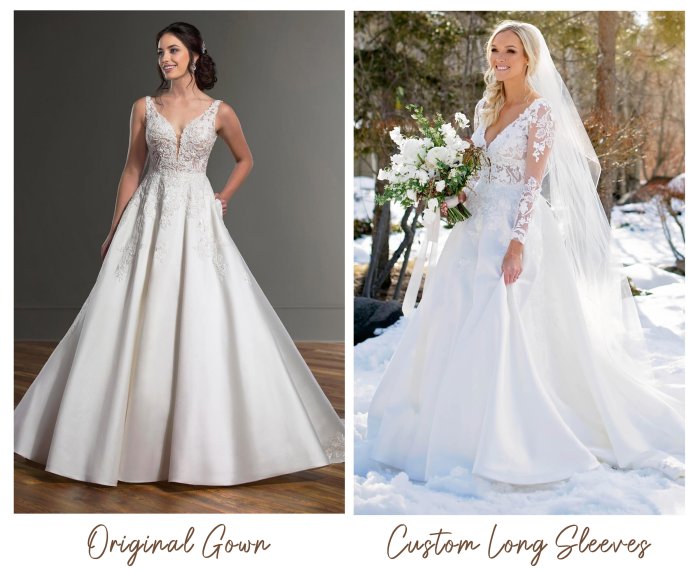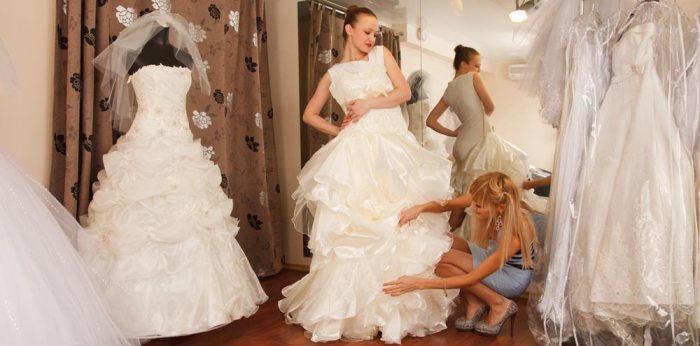Wedding Dress Alterations Salt Lake City
Finding Reputable Wedding Dress Alteration Services in Salt Lake City
Wedding dress alterations salt lake city – Finding the perfect wedding dress is just the first step; ensuring it fits flawlessly requires skilled alterations. Salt Lake City boasts several talented seamstresses specializing in wedding dress alterations. This section provides a directory of reputable businesses, their services, and typical pricing.
Reputable Wedding Dress Alteration Businesses in Salt Lake City, Wedding dress alterations salt lake city
The following table lists several alteration businesses, though this is not an exhaustive list. Always verify current contact information and availability before scheduling a consultation.
| Business Name | Address | Phone Number | Website |
|---|---|---|---|
| [Business Name 1] | [Address 1] | [Phone Number 1] | [Website 1] |
| [Business Name 2] | [Address 2] | [Phone Number 2] | [Website 2] |
| [Business Name 3] | [Address 3] | [Phone Number 3] | [Website 3] |
| [Business Name 4] | [Address 4] | [Phone Number 4] | [Website 4] |
These businesses typically offer a range of alterations including hemming, taking in seams, adding sleeves, bustle installation, train adjustments, and neckline modifications. Specific services and expertise may vary.
Typical Price Ranges for Wedding Dress Alterations
The cost of wedding dress alterations in Salt Lake City varies significantly depending on the complexity of the alterations, the type of fabric, and the experience of the seamstress. Basic alterations like hemming may cost between $100-$300, while more complex alterations, such as adding sleeves or a significant amount of seam work, can range from $300 to $1000 or more.
The Wedding Dress Alteration Process
Successfully altering a wedding dress involves several key steps, from initial consultation to final fitting. Clear communication and careful planning are crucial for a positive experience.
Steps Involved in Wedding Dress Alterations
- Initial Consultation: Discuss desired alterations, review the dress, and obtain measurements.
- Measurements and Assessment: The seamstress assesses the dress and determines the feasibility and cost of the alterations.
- Alteration Planning: A detailed plan is created, outlining the specific alterations and timeline.
- First Fitting: The dress is fitted, and adjustments are made based on the initial alterations.
- Second (and subsequent) Fittings: Additional fittings ensure a perfect fit and address any necessary adjustments.
- Final Fitting: The final fitting confirms the dress fits perfectly, and any final adjustments are made.
- Dress Pickup: The completed dress is picked up.
Importance of Choosing the Right Seamstress and Communication
Selecting an experienced and reputable seamstress is paramount. Clear communication about desired alterations prevents misunderstandings and ensures the final product meets expectations. Thoroughly reviewing online reviews and testimonials can provide valuable insights into a seamstress’s skills and customer service.
Common Types of Wedding Dress Alterations
Numerous alterations can enhance a wedding dress’s fit and style. This section explores common alterations, their techniques, and the resulting visual transformations.
Common Alterations Explained
- Hemming: Shortening the length of the dress to achieve the desired hemline. This involves removing excess fabric from the bottom of the gown.
- Taking in Seams: Reducing the size of the dress to create a more fitted silhouette. This may involve adjusting side seams, bust darts, or other areas.
- Adding Sleeves: Adding sleeves to a sleeveless dress, often requiring careful fabric matching and seam construction.
- Bustle Addition: Adding a bustle to lift the train of the dress, allowing for easier movement during the reception.
- Train Adjustments: Modifying the length or shape of the train to better suit the bride’s preferences or venue.
- Neckline Modifications: Altering the neckline of the dress, such as raising or lowering it, or changing the shape.
Illustrative Examples of Before-and-After Alterations

Source: squarespace-cdn.com
A simple A-line dress, before hemming, might appear too long and drag on the floor. After hemming, the dress falls gracefully at the bride’s desired length, enhancing her posture and movement. A ballgown with a large, heavy train might be difficult to manage during the reception. After the addition of a bustle, the train is elegantly lifted, creating a more manageable and comfortable look.
A dress with a low neckline that the bride feels is too revealing might be adjusted to raise the neckline slightly, providing a more modest and comfortable fit.
Factors Influencing Cost and Timeline
Several factors influence the cost and timeline of wedding dress alterations. Understanding these elements allows for better planning and budgeting.
Factors Affecting Alteration Costs
The complexity of the alterations significantly impacts the cost. Intricate beading, lacework, or unusual fabrics require more time and skill, increasing the price. The type of fabric also plays a role; delicate fabrics are more challenging to work with, leading to higher costs. The seamstress’s experience and reputation also influence pricing; experienced seamstresses often charge more due to their expertise.
Impact of Timing on Alterations
Starting alterations early is crucial. Rushing the process can lead to compromises in quality or increased costs due to expedited service. A realistic timeline allows for multiple fittings and ensures a perfect fit. Delays can arise from unforeseen circumstances, so building in buffer time is recommended.
Realistic Timeline for Common Alterations
A typical timeline for alterations, starting approximately 2-3 months before the wedding, allows for multiple fittings and adjustments. However, complex alterations may require a longer timeline, possibly 4-6 months or more. This should be discussed with the chosen seamstress to determine a personalized schedule.
Choosing the Right Seamstress
Selecting a skilled and reliable seamstress is crucial for a successful alteration process. This section provides guidance on choosing the right professional.
Advice on Selecting a Seamstress

Source: showit.co
Thoroughly research potential seamstresses. Check online reviews and testimonials on platforms like Yelp or Google Reviews to gauge their reputation and client experiences. Look for seamstresses specializing in wedding dress alterations; their expertise in working with bridal fabrics and styles is invaluable. Consider visiting their studio to assess their workspace and get a feel for their professionalism.
Finding the perfect wedding dress in Salt Lake City often involves alterations to achieve the desired fit and style. Many brides choose unique themes, and if you’re considering a bold look, you might explore the edgy designs showcased on websites like rock and roll wedding dresses for inspiration. Regardless of your chosen style, a skilled alterations specialist in Salt Lake City can help you refine your dress to perfection, ensuring you feel amazing on your big day.
Preparing for a Seamstress Consultation
Bring the wedding dress, undergarments (including the bra and any shapewear you plan to wear on your wedding day), and the shoes you intend to wear to the consultation. This allows the seamstress to accurately assess the fit and make necessary adjustments. Prepare a list of questions and any reference images illustrating the desired alterations.
Preparing for Your Alterations Appointment: Wedding Dress Alterations Salt Lake City

Source: com.au
Proper preparation ensures a smooth and efficient alteration process. This section provides a checklist and key questions to ask your seamstress.
Essential Items for Alterations Appointments
- Wedding dress
- Undergarments (bra, shapewear, etc.)
- Shoes
- Veil (if applicable)
- Any accessories that will be worn with the dress
- Inspiration photos or sketches
- List of questions
Questions to Ask Your Seamstress
- What is your experience with wedding dress alterations?
- What types of alterations do you specialize in?
- What is your estimated cost for the alterations?
- What is your turnaround time?
- How many fittings are typically required?
- What is your cancellation policy?
FAQ Insights
How far in advance should I schedule my alterations?
Ideally, schedule your first consultation 6-8 weeks before your wedding, allowing ample time for fittings and adjustments.
What should I bring to my first consultation?
Bring your wedding dress, undergarments (bra, shapewear), shoes, and any accessories you plan to wear.
What if I need emergency alterations close to my wedding?
Contact several seamstresses immediately; explain your urgency. Some may have limited availability but may prioritize urgent requests.
Can alterations change the overall style of my dress?
While alterations primarily focus on fit, skilled seamstresses can sometimes subtly adjust elements like the neckline or sleeves to enhance the overall style.
Are there payment plans available for alterations?
Inquire directly with the seamstress; some may offer payment plans or flexible payment options.



















